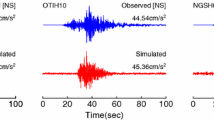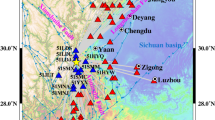Abstract
The Ya’an, Sichuan Mw 6.7 earthquake occurred on April 20, 2013. In this article, the stochastic finite-fault method (EXSIM) based on dynamic corner frequency, proposed by Motazedian and Atkinson (Bull Seismol Soc Am 95(3):995–1010, 2005), is validated to be an intelligible and productive approach for the generation of high-frequency strong ground motion. The validated model parameters were considered for the simulation at 31 selected stations, which are less than 200 km away from the fault. The input parameters included site condition, source term, and path term. The calibration of the input parameters, such as the stress drop, was achieved by using misfit functions between the observed PSA (pseudo-acceleration response spectra) and simulated PSA in the time domain. Some of the other parameters, such as distance-dependent duration, high-frequency attenuation parameter kappa, and local amplification functions, were calibrated by considering the observed recordings. In this study, we attempted to employ two different slip models for strong ground motion simulation, so that the influence on the simulation results can be revealed. Our results depicted that although the method cannot combine well, the directivity effects and the soil conditions are not adequately represented at individual stations, the synthetics satisfactorily match with the seismic characteristics regarding peak ground acceleration (PGA), response spectra, Fourier spectrum, and time history, for both the time and frequency range considered. The results also demonstrated that there is a slight difference between the simulation results of the two slip models. Finally, we compared the effects of different distance-dependent duration models for the simulated PGA. It illustrates that it is difficult to find a balance between the ground motion duration and PGA at stations with fault distance less than 20 km, which makes the duration and PGA to coincide well with the observed recordings.















Similar content being viewed by others
References
Aki K (1967) Scaling law of seismic spectrum. J Geophys Res 72(4):1217–1231
Aki K (1981) Scattering and attenuation of high frequency body waves (1–25 Hz) in the lithosphere. Phys Earth Planet Inter 26(4):241–243
Anderson JG, Hough SE (1984) A model for the shape of the Fourier amplitude spectrum of acceleration at high frequencies. Bull Seismol Soc Am 74(5):1969–1993
Atkinson GM (1996) The high-frequency shape of the source spectrum for earthquake in eastern and western Canada. Bull Seismol Soc Am 86(1):106–112
Atkinson GM (2004) Empirical attenuation of ground motion spectral amplitudes in southeastern Canada and the northeastern United States. Bull Seismol Soc Am 94(3):1079–1095
Atkinson GM, Mereu RF (1992) The shape of ground motion attenuation curves in southeastern Canada. Bull Seismol Soc Am 82(5):2014–2031
Atkinson GM, Boore DM (1998) Evaluation of models for earthquake source spectra in Eastern North America. Bull Seismol Soc Am 88(4):917–934
Atkinson GM, Boore DM (2006) Earthquake ground-motion prediction equations for eastern North America. Bull Seismol Soc Am 96(6):2181–2205
Beresnev IA, Atkinson GM (1997) Modeling finite-fault radiation from the ωn spectrum. Bull Seismol Soc Am 87(1):67–84
Beresnev IA, Atkinson GM (1998a) FINSIM-a FORTRAN program for simulating stochastic acceleration time histories from finite faults. Seismol Res Lett 69(1):27–32
Beresnev IA, Atkinson GM (1998b) Stochastic finite-fault modeling of ground motion from the 1994 Northridge, California, earthquake. 1. Validation on rock sites. Bull Seismol Soc Am 88(6):1392–1401
Boore DM (1983) Stochastic simulation of high-frequency ground motions based on seismological models of the radiated spectra. Bull Seismol Soc Am 73(6):1865–1894
Boore DM (2003) Simulation of ground motion using the stochastic method. Pure Appl Geophys 160(3):635–676
Boore DM (2009) Comparing stochastic point-source and finite-source ground-motion simulations: SMSIM and EXSIM. Bull Seismol Soc Am 99(6):3202–3216
Boore DM, Joyner WB (1997) Site amplifications for generic rock sites. Bull Seismol Soc Am 87(2):327–341
Borcherdt RD (1970) Effects of local geology on ground motion near San Francisco Bay. Bull Seismol Soc Am 60(1):29–61
Brune JN (1970) Tectonic stress and the spectra of seismic shear waves from earthquake. J Geophys Res 75(26):4997–5009
Castro RR, Rovelli A, Cocco M, Bona MD, Pacor F (2001) Stochastic simulation of strong-motion records from the 26 September 1997 (Mw 6), Umbria-Marche (central Italy) earthquake. Bull Seismol Soc Am 91(1):27–39
Castro RR, Pacor F, Franceschina G, Bindi D (2008) Stochastic strong-motion simulation of the Mw 6 Umbria-Marche earthquake of September 1997: comparison of different approaches. Bull Seismol Soc Am 98(2):662–670
Chen C, Xu Y (2013) Relocation of the Lushan Ms 7.0 earthquake sequence and its tectonic implication. Chin J Geophys 56(12):4028–4036 (in Chinese with English abstract)
Chen CH, Chang SC, Wen KL (2017) Stochastic ground motion simulation of the 2016 Meinong, Taiwan earthquake. Earth Planets Space 69:62. https://doi.org/10.1186/s40623-017-0645-z
Drouet S, Chevrot S (2008) Simultaneous inversion of source spectra, attenuation parameters, and site responses: application to the data of French Accelerometric Network. Bull Seismol Soc Am 98(1):198–219
Ghasemi H, Fukushima Y, Koketsu K, Miyake HZ, Wang H, Anderson JG (2010) Ground-motion simulation for the 2008 Wenchuan, China, earthquake using the stochastic finite-fault method. Bull Seismol Soc Am 100(5B):2476–2490
Hanks TC, McGuire RK (1981) The character of high frequency strong ground motion. Bull Seismol Soc Am 71(6):2071–2095
Hartzell SH (1978) Earthquake aftershocks as Green’s functions. Geophys Res Lett 5(1):1–14
Hassani B, Atkinson GM (2015) Referenced empirical ground-motion model for eastern North America. Seismol Res Lett 86(2):477–491
Herrmann RB (1985) An extension of random vibration theory estimates of strong ground motion to large earthquake. Bull Seismol Soc Am 75(5):1447–1453
Hua W, Chen ZL, Zheng SH (2009) A study on segmentation characteristics of aftershock source parameters of Wenchuan Ms 8.0 earthquake in 2008. Chin J Geophys 52(2):365–371 (in Chinese with English abstract)
Huang H, Teng T (1999) An evaluation on H/V ratio vs. spectral ratio for site-response estimation using the 1994 Northridge earthquake sequences. Pure Appl Geophys 156(4):631–649
Husid P (1967) Gravity effects on the earthquake response of yielding structures. California Institute of Technology, California
Husid RL (1969) Analisis de terremotos, Analisis general. Revista del IDIEM 8(1):21–42
Jin A, Aki K (1988) Spatial and temporal correlation between coda Q and seismicity in China. Bull Seismol Soc Am 78(2):741–769
Joyner WB, Fumal T (1985) Predictive mapping of ground motion, in evaluating earthquake hazards in the Los Angeles Region. In: Ziony (ed). United States Geological Survey Profess Paper, pp 203–220
Konno K, Ohmachi T (1998) Ground-motion characteristics estimated from spectral ratio between horizontal and vertical component of microtremor. Bull Seismol Soc Am 88(1):228–241
Ktenidou OJ, Gelis C, Bonilla LF (2013) A study on the variability of kappa (κ) in a borehole: implications of the computation process. Bull Seismol Soc Am 103(2A):1048–1068
Lermo J, Chavez GFJ (1993) Site effect evaluation using spectral ratios with only one station. Bull Seismol Soc Am 83(5):1574–1594
Mitchell BJ (1995) Anelastic structure and evolution of the continental crust and upper mantle from seismic surface wave attenuation. Rev Geophys 33(4):441–462
Motazedian D (2006) Region-specific key seismic parameters for earthquakes in northern Iran. Bull Seismol Soc Am 96(4):1383–1395
Motazedian D, Atkinson GM (2005) Stochastic finite-fault modeling based on a dynamic corner frequency. Bull Seismol Soc Am 95(3):995–1010
Moya A, Aguirre J, Irikura K (2000) Inversion of source parameters and site effects from strong ground motion records using genetic algorithms. Bull Seismol Soc Am 90(4):977–992
National Strong Motion Network Center (2014) China strong earthquake record report: uncorrected acceleration records of Lushan Ms 7.0 earthquake and aftershocks. Earthquake Press, Beijing, pp 1–419
RaghuKanth STG, Kavitha B (2013) Stochastic finite fault modeling of subduction Zone Earthquakes in Northeastern India. Pure Appl Geophys 170(11):1705–1727
Roumelioti Z, Kiratzi A, Theodulidis N (2004) Stochastic strong ground-motion simulation of the 7 September 1999 Athens (Greece) earthquake. Bull Seismol Soc Am 94(3):1036–1052
Sun XD, Tao XX, Duan SS, Liu CQ (2013) Kappa (k) derived from accelerograms recorded in the 2008 Wenchuan mainshock, Sichuan, China. J Asian Earth Sci 73(2013):306–316
Ugurhan B, Askan A (2010) Stochastic strong ground motion simulation of the 12 November 1999 Duzce (Turkey) earthquake using a dynamic corner frequency approach. Bull Seismol Soc Am 100(4):1498–1512
Wang D, Xie LL, Abrahamson NA (2010) Comparison of strong ground motion from the next generation attenuation (NGA) ground-motion models. Bull Seismol Soc Am 100(5B):2381–2395
Wang WM, Hao JL, Yao ZX (2013) Preliminary result for rupture progress of Apr. 20, 2013, Lushan earthquake, Sichuan, China. Chin J Geophys 56(4):1412–1417 (in Chinese with English abstract)
Wang GX, Ding Y, Borcherdt R (2015) Simulation of acceleration field of the Lushan earthquake (Ms 7.0, April 20, 2013, China). Eng Geol 189(2015):84–97
Wells and Coppersmith (1994) New empirical relationship among magnitude, rupture length, rupture width, rupture area, and surface displacement. Bull Seismol Soc Am 84(4):974–1002
Wen RZ, Wang HW, Ren YF, Ji K (2015) Estimation of source parameters and quality factor based on generalized inversion method in Lushan earthquake. J Harbin Inst Technol 47(4):58–63 (in Chinese with English abstract)
Xie JJ, Li XJ, Wen ZP (2014) Near-source vertical and horizontal strong ground motion from the 20 April 2013 Mw 6.8 Lushan earthquake in China. Seismol Res Lett 85(1):23–33
Xie JJ, Li XJ, Wen ZP (2018) Variations of near-fault strong ground motion with directions during the 2014 Lushan Ms 7.0 earthquake. Chin J Geophys 61(4):1266–1280 (in Chinese with English abstract)
Yu Y (2012) Empirical estimate model for ground motion of Wenchuan earthquake zone. Institute of Engineering Mechanics, China Earthquake Administration, Harbin (in Chinese with English abstract)
Zafarani H, Rahimi M, Noorzad A, Hassani B, Khazaei B (2015) Stochastic simulation of strong-motion records from the 2012 Ahar-Varzaghan dual earthquakes, northwest of Iran. Bull Seismol Soc Am 105(3):1419–1434
Zengin E, Eser C (2014) Ground motion simulations for the 23 October 2011 Van, Eastern Turkey earthquake using stochastic finite fault approach. Bull Earthq Eng 12(2):627–646
Zhang PZ, Xu XW, Wen XZ (2008) Slip rates and recurrence intervals of the Longmen Shan active fault zone and tectonic implications for the mechanism of the May 12 Wenchuan earthquake, 2008, Sichuan, China. Chin J Geophys 51(4):1066–1073 (in Chinese with English abstract)
Acknowledgments
This research was supported by the National Natural Science Foundation of China under Grant Nos. 51378479 and 51078337. The authors would like to thank Jian Song for his sincerely help in drawing images using Generic Mapping Tools (GMT) software. Appreciations are also given to Boore, who selflessly shared his stochastic finite-fault simulation program code. The most important thanks are to Xiaodan Sun, who is an associate professor at Southwest Jiaotong University. Last but not least, the author also thanks the two anonymous reviewers for their valuable comments and advise. The observed acceleration time histories of Lushan earthquake were provided by China Strong Motion Network Center (CSMNC).
Author information
Authors and Affiliations
Corresponding author
Additional information
Publisher's Note
Springer Nature remains neutral with regard to jurisdictional claims in published maps and institutional affiliations.
Rights and permissions
About this article
Cite this article
Dang, P., Liu, Q. Stochastic finite-fault ground motion simulation for the Mw 6.7 earthquake in Lushan, China. Nat Hazards 100, 1215–1241 (2020). https://doi.org/10.1007/s11069-020-03859-3
Received:
Accepted:
Published:
Issue Date:
DOI: https://doi.org/10.1007/s11069-020-03859-3




